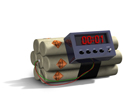
When The Right Suit Really Matters
When a bomb technician inspects a potential explosive device, the bulky protective suit might be the only defense they have. Bomb suit manufacturers run tests on their protective suits to ensure they can withstand an explosion, but there currently is no single set of requirements that the suits must meet before they can be sold.
To ensure bomb suits do provide sufficient protection, several federal agencies are working with first responders to develop a standard for minimum performance requirements. If adopted, the requirements would be the first nationwide standard governing bomb suits.
The Department of Homeland Security (DHS) Science and Technology Directorate (S&T) Test & Evaluation and Standards Division (TSD) and the Department of Justice National Institute of Justice (NIJ) supported the effort to develop a bomb suit standard at the urging of the first responder community, according to Debra Stoe, senior program operations specialist and physical scientist for the NIJ Office of Science and Technology Operational Technologies Division. It began when NIJ funded an effort by the National Institute of Standards and Technology (NIST) and the U.S. Army Natick Soldier Research Development and Engineering Center (NSRDEC) to analyze technology needs facing first responders.
During that process, bomb technicians mentioned the need for a bomb suit standard. “When a practitioner comes to us and says we have a need for this, we look [to see if there] is something we can do,” Stoe said.
In response, TSD and NIJ funded technical analysis of bomb suit capabilities by NIST and NSRDEC. The research formed the foundation for the standard’s development.
Technicians wanted a standard to help bomb squads make educated decisions when purchasing equipment, according to Martin Hutchings, a retiree of the Sacramento County, California Sheriff’s Department bomb squad and NIST liaison to the National Bomb Squad Commanders Advisory Board. Once the standard is adopted, bomb squads will know that suits meet the minimum performance requirements.
“The bomb suit is such an important piece of equipment that a standard and certification program was needed to ensure a bomb technician’s safety,” Hutchings said.
To develop the standard, federal agencies first researched the most common types of explosives bomb squads encounter, according to Philip J. Mattson, deputy director of the Office of Standards at TSD. No bomb suit can protect a technician from every potential threat, but federal officials and bomb technicians sought out a standard suit to shield first responders from the most common explosives.
NSRDEC personnel blew up, burned, and projected fragments at suits to determine what kinds of tests suits would need to pass to ensure they protect bomb technicians adequately. According to the NIST Office of Law Enforcement Standards, NSRDEC, and NIJ, the drafted standard contains requirements for:
- Cushioning the spine and head during impact.
- Blast and thermal heat protection.
- Freedom of motion to work efficiently.
- Maximum weight restrictions.
- Rapid removal, such as for emergency medical treatmen.
- Freedom of motion (allowing sufficient dexterity to pick up a coin from the ground).
- Defogger performance to prevent the helmet visor from clouding.
Having a standard will give some assurance of quality to DHS and other agencies that award grants to bomb squads for equipment purchases, according to Mattson. If the standard is adopted, DHS will change its grants process to ensure awards are spent on bomb suits that meet the requirements.
The groups that worked to develop the standard hope it will be adopted by the end of 2010, according to Stoe. Once NIJ formally establishes a standard, it will be reviewed every three to five years to ensure it meets the current needs of first responders.
“When it comes to a bomb suit, the practitioner’s life depends on the quality of that garment,” Stoe said.
For more information on the proposed standard, visit http://www.ojp.usdoj.gov/nij/topics/technology/standards-testing/under-development.htm#bombsuit.